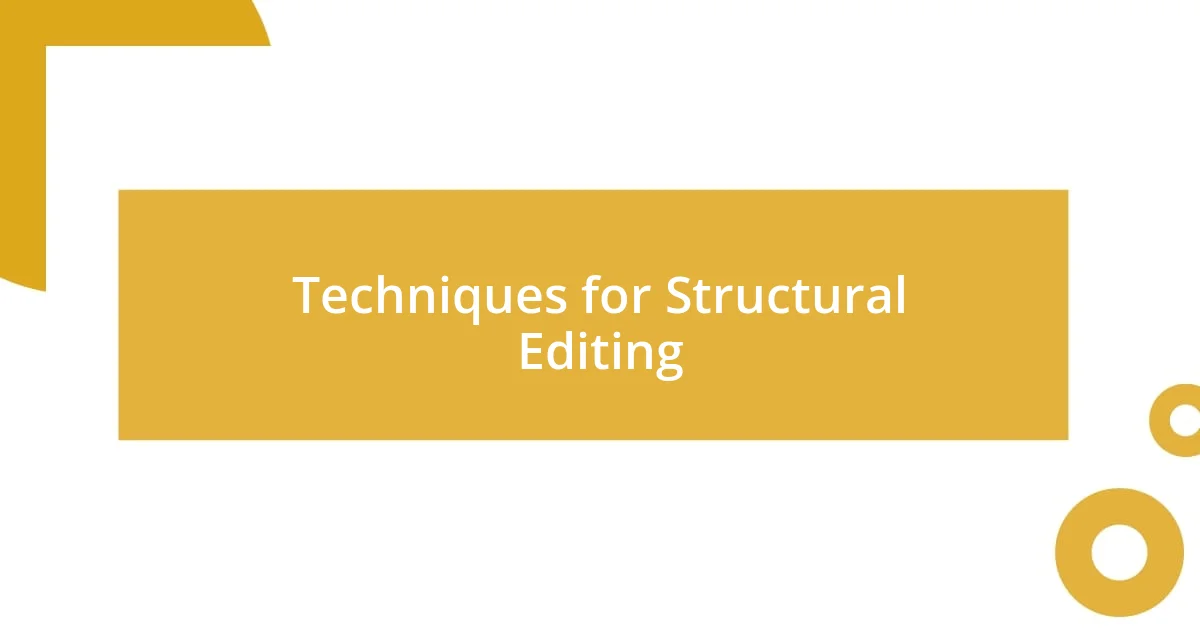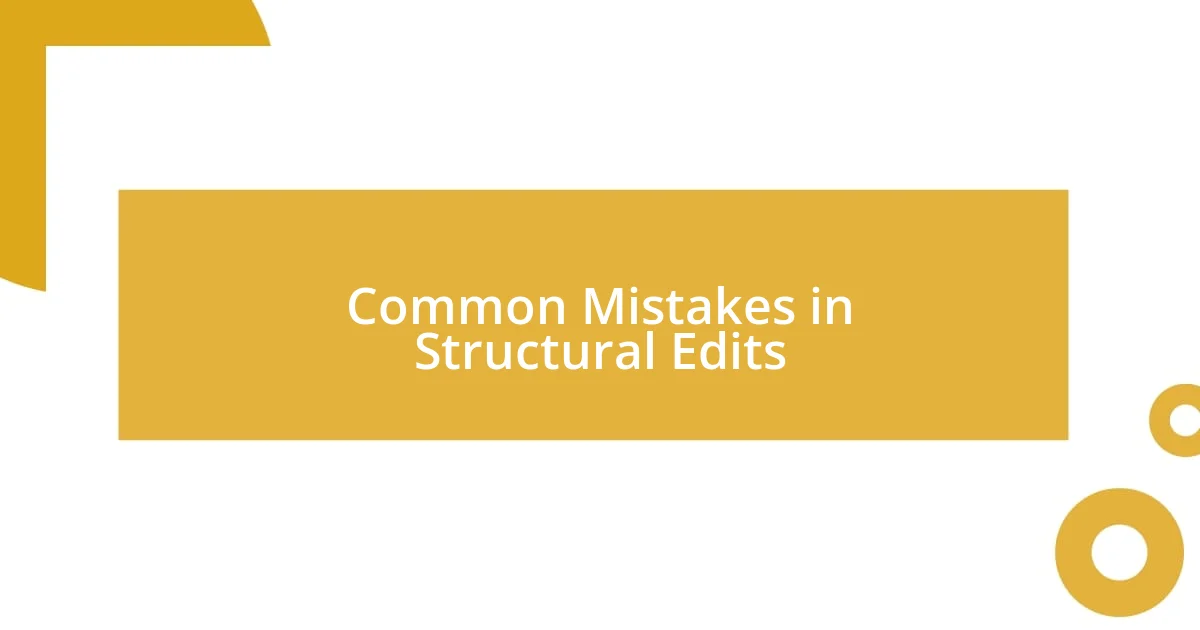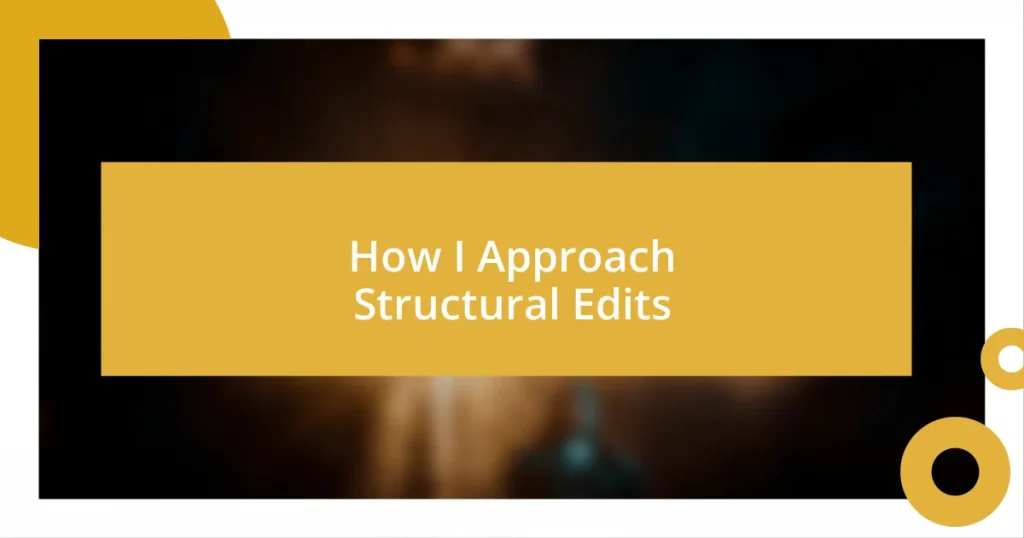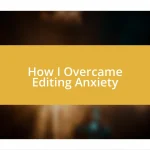Key takeaways:
- Structural edits enhance clarity, flow, character development, and emotional impact, significantly improving reader engagement.
- Techniques like reading aloud, storyboarding, and seeking feedback from beta readers can effectively identify and resolve structural issues.
- Common mistakes include neglecting character growth, mismanaging pacing, and failing to maintain consistent themes, which can weaken the narrative.

Understanding Structural Edits
Structural edits can feel daunting, but they are crucial for elevating a manuscript to its fullest potential. I remember the first time I faced structural edits on my own work; it was like peeling back layers of an onion, revealing the core of what truly mattered. Have you ever read something and felt like it could have been so much better with just a few changes? That’s the power of structural edits.
When I think about structural edits, I see them as a roadmap for clarity and flow in storytelling. Consider how a great book seamlessly guides you from one chapter to the next; that’s often the result of careful structural consideration. It’s not just about correcting grammar or punctuation; it’s about ensuring that characters and events are balanced, dramatic tension is appropriately build, and the pacing keeps readers engaged.
What’s fascinating is the emotional impact structural edits can have on the reader’s experience. I’ve experienced moments where restructuring a few paragraphs reinvigorated my connection to the story I was trying to tell. Remember, edits are not just revisions—they’re a chance to dig deeper into your narrative and make the emotional resonance even stronger. Isn’t that what we all want as writers?

Importance of Structural Edits
Structural edits serve as the backbone of a well-crafted manuscript. I recall revisiting a story that felt muddled; the characters were intriguing, but their journeys didn’t align. It was through structural edits that I was able to reframe their paths, weaving their arcs so they enhanced each other rather than competing for attention. That made a significant difference in the overall impact.
When I consider the importance of structural edits, it’s clear that they foster a stronger connection between the story and its audience. One time, I faced a manuscript where the climax was lost amidst too many subplots. By rearranging some elements, the tension built compellingly, and I noticed how readers became more engrossed. I believe this kind of thoughtful editing transforms the reading experience from merely consuming words to feeling them.
Moreover, structural edits aren’t only about the narrative flow; they challenge us as writers. I often find that tightening the structure reveals hidden themes and deeper character motivations. It’s exhilarating to discover these connections and realize how much more powerful the story can become. Have you ever uncovered a new layer in your writing that excited you? That’s the essence of engaging in structural edits—they bring your creative vision to life.
| Aspect | Impact of Structural Edits |
|---|---|
| Clarity | Enhances understanding of the narrative |
| Flow | Creates a seamless reading experience |
| Character Development | Balances character arcs for deeper engagement |
| Emotional Impact | Strengthens reader’s emotional connection |
| Thematic Depth | Uncovers hidden themes within the narrative |

Steps to Identify Structural Issues
To identify structural issues in a manuscript, I often start by reading it aloud. This simple act can reveal awkward phrases and pacing problems that might go unnoticed in silent reading. It’s like giving the story a voice, which can highlight areas that disrupt the flow or confuse the reader’s understanding.
- Make note of sections where you stumble or lose engagement; these spots often signal structural weaknesses.
- Pay attention to the beginning and end of chapters; they should create intrigue and closure respectively.
- Reflect on character arcs—do they evolve logically, or does something feel off? This often points to deeper issues in structure.
Another approach I find effective is to map out the story’s outline. I’ve done this with my own stories, creating visual representations of the plot. I discovered that while one subplot was compelling, it overshadowed the main narrative, diluting emotional impact. As I rearranged the outline, I noticed how clarity improved.
- Sketch a timeline of events to visualize pacing and climaxes.
- Identify any scenes that seem disconnected; they might need to be integrated or removed.
- Emotional pacing matters—are there peaks of tension followed by adequate release? This balance is crucial for reader engagement.
Taking a step back to analyze these factors really transforms my editing process. It’s fascinating to find solutions that deepen the reader’s connection with the story. I remember feeling a rush of excitement when I reshuffled scenes to create a stronger emotional arc; the story felt alive in a new way.

Techniques for Structural Editing
When I dive into structural editing, I often employ the technique of creating a detailed storyboard. I find that visually representing scenes helps clarify the overall journey and pacing. Recently, while working on a manuscript, I lowered the odds of losing narrative threads by seeing how each scene linked to the next. It’s almost like piecing together a jigsaw puzzle; you can easily spot the gaps that need filling. Have you tried this method? It’s amazing how a little visual structure can yield significant insights.
Another technique that I haven’t mentioned yet is the use of feedback loops. After drafting a piece, I like to share it with a trusted group of beta readers. Listening to their perspectives often shines light on structural missteps I may have overlooked. One time, a friend pointed out that a significant plot twist wasn’t landing because the setup was too weak. This feedback spurred me to strengthen earlier connections, enhancing both the twist and the overall flow. It’s a reminder that fresh eyes can unveil blind spots in our storytelling.
I’ve also found that considering the reader’s emotional journey is essential during structural edits. I often ask myself, “What do I want the reader to feel at this moment?” This question has guided me through challenging sections, allowing me to decide if a scene needed more tension or perhaps a pause for reflection. In one editing session, I restructured a climactic moment to build suspense gradually instead of rushing it. The result wasn’t just a rearranged plot; it became an experience that resonated with readers on a deeper level. Don’t you think understanding our audience’s emotional landscape can transform our narrative craft?

Tools for Structural Edits
When it comes to structural edits, I often find myself reaching for software tools that enhance my editing efficiency. One tool I rely on is Scrivener. Its ability to organize chapters and scenes into a visual layout helps me see the overall structure at a glance. During one project, I was wrestling with a complex narrative timeline; using Scrivener allowed me to shuffle scenes with ease, ultimately revealing a smoother flow that I hadn’t noticed before. Have you experienced a similar moment where technology just clicks and changes everything?
Another resource I absolutely love is the use of mind-mapping apps like MindMeister. This approach lets me brainstorm plot points and character arcs visually. I vividly remember using this tool while revising a particularly tangled storyline. By mapping it out, I could pinpoint where subplots were losing traction or confusing readers. It’s incredible how visualizing your thoughts can help untangle the mess in a manuscript, don’t you think?
I also appreciate the power of comments and track changes features in programs like Microsoft Word or Google Docs. The collaborative aspect can be transformative. I recall sharing a draft with a fellow writer who meticulously commented on areas where clarity faltered. Her insights were invaluable; I wouldn’t have considered those points without her fresh perspective. Relying on tools that facilitate collaboration can illuminate different angles and lead to structural improvements you might not foresee on your own. Seeing the story from someone else’s viewpoint is such a gift, right?

Common Mistakes in Structural Edits
One of the most common mistakes I encounter in structural edits is neglecting character arcs. It’s crucial to remember that each character should evolve throughout the story. I once edited a manuscript where a main character remained stagnant despite facing significant challenges. This oversight not only weakened the narrative but also left readers feeling disconnected. How can we expect readers to invest emotionally if the characters don’t undergo meaningful growth?
Another pitfall is mismanaging pacing. I vividly recall a project where a climactic scene was overshadowed by an extended flashback preceding it. This choice deflated the tension I had labored to build throughout the preceding chapters. It’s essential to balance action-packed moments against quieter reflective sections. Have you experienced a similar frustration where misplaced pacing derailed your narrative flow?
I also often see structural edits that fail to maintain consistent thematic elements. Failing to weave these threads can leave the reader confused about the story’s central message. I once revised a story that started strong with a clear theme of redemption but meandered into unrelated subplots that muddied the waters. Reflecting on these aspects can sharpen focus and sense in storytelling, don’t you think?

Finalizing Your Structural Edits
When I finally sit down to finalize my structural edits, I like to take a moment to step back and look at the manuscript as a whole. There’s something empowering about seeing your work in this broader light, almost like being a director viewing the final cut of a film. I remember a time I took a Sunday afternoon to re-read an entire draft aloud, and it revealed awkward transitions and redundancies I hadn’t recognized before. Don’t you find that hearing the words out loud can highlight issues in a way that reading silently doesn’t?
After I identify the larger structural issues, I delve into the finer details. One thing I make sure to perfect is the flow between chapters. I often include intentional cliffhangers or thematic tie-ins that resonate from one chapter to the next. On one project, a simple tweak in the final sentence of a chapter transformed it from a simple transition to a compelling invitation for the reader to keep turning pages. What small adjustments have you made that significantly enhanced your narrative flow?
Finally, I always make room for feedback in my finalization process. It’s an invaluable step in ensuring that my edits resonate not just with me, but with potential readers as well. Sharing the revised manuscript with a trusted group or a critique partner often reveals blind spots I didn’t see. I recall receiving feedback on a pivotal chapter where a reader pointed out that the emotional stakes weren’t as high as they could be. Their insight led me to deepen the character’s motivations, which ultimately elevated the story’s impact. Isn’t it amazing how collaboration can breathe new life into our work?















